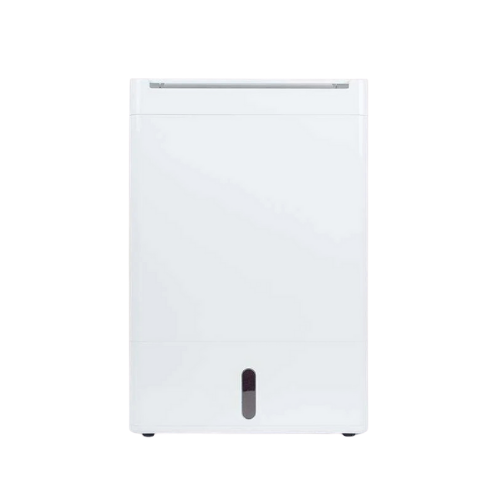How does a desiccant dehumidifier work?
3 Key Takeaways:
🚀 A desiccant dehumidifier works by drawing in moist air and then forcing it through a desiccant material, usually a silica gel or calcium chloride, that absorbs moisture from the air.
🚀 Desiccant dehumidifiers are a great choice to maintain humidity levels by removing excess moisture from the air and are known for their silent operation.
🚀 Desiccant dehumidifiers work best for cold temperatures and places that are constantly exposed to high humidity or have a cold surface most times like bathrooms, basements, etc.
It is always best to be aware of the different types of dehumidifiers and how each of them works before buying a dehumidifier. Compressor dehumidifiers or refrigerant dehumidifiers and desiccant dehumidifiers may all deliver the same relief from excess moisture in the air. But the manner in which they process air during the dehumidification process is different.
How does the desiccant material, which is silica gel in most cases, works inside desiccant units is indeed an interesting formula.
Let us learn more about how desiccant dehumidifiers work to remove moisture from the air and maintain the relative humidity level of an area.
When do you need a desiccant dehumidifier?

It is always better to be confident about what your home needs between the two viable choices before buying a dehumidifier. A desiccant and compressor model are different units at both ends of the spectrum. The advantages and disadvantages of desiccant dehumidifiers and compressor dehumidifiers also differ. After fully understanding how desiccant dehumidifiers work and the nature of a desiccant material like silica gel, you will be able to access which unit will suit your requirements.
A desiccant dehumidifier is a great choice to maintain humidity levels by removing the excess moisture from the air. Silica gel is a desiccant material that is easy to get and way more affordable than a compressor dehumidifier. Here is what will make you realize if your home needs a compressor model or a desiccant unit.
Be it a home, bedroom, bathroom, office, garage, or basement; if the area is in need of removing moisture but is also famous for the low temperatures it runs into this is where desiccant units will come to the rescue. The ability of desiccant material like silica gel to process air, changing damp and moist air to dry air is a process that works best for cold temperatures.
Desiccant dehumidification with its mechanism to process air is the right choice for a place with a room temperature that this always low or a place that has the necessity to be maintained at a specific relative humidity level.
Places that are constantly exposed to high humidity or have a cold surface most times like bathrooms, basements, campers, boats, food industry, etc., are places where desiccant units will come in handy.
In addition to the ability to function seamlessly in low room temperature areas, desiccant units are also quieter. Compressor dehumidifiers work with refrigerant material that will have warm air running over the cold surface of the coil. We will look in detail at the method of how compressor dehumidifiers work to process air and operate in an area with too much humidity. But, during this process of reducing moisture in the air, the unit will also generate a lot of noise.
Desiccant units are known for their silent operation. Silica gel will simply absorb the moisture from the air. And while this moisture in the air is being absorbed or removed, there is little to no power consumption and noise generation. This silent operation might be what you expect for your room. For example, a bedroom or office where more moisture content in the environment has been a problem, and where a silent dehumidification process will be useful.
Minimal power consumption, ideal for lower temperatures (especially) or warmer temperatures, or small spaces, and where less noise is preferred; moisture removal for any area like this would highly benefit from a desiccant unit.
How do desiccant dehumidifiers work?
The dehumidification process by a desiccant and compressor dehumidifier is not very much alike. They both are excellent at managing the high relative humidity levels in an area by their own method of regulating the air flow. How desiccant dehumidifiers function to remove moisture in the air using silica gel as their desiccant material will be discussed in detail here.
From the outside, a desiccant unit might look quite similar to compressor dehumidifiers. In a compressor dehumidifier, the more moisture content that enters the unit will be passed over the cold surface, during which the water vapor acts upon it and the water condenses and gets collected. This does not happen during desiccant dehumidification. For desiccant dehumidifiers to carry out moisture removal from the air, we have a slowly rotating wheel or desiccant wheel and reactivation air involved. Let us understand more about the slowly rotating wheel and the reactivation air.
Desiccant dehumidifier operation:
Converting moist air into dry air inside the unit goes like this.
To process air that enters the unit, it is slowly moved across the desiccant wheel. This desiccant wheel will extract the moisture content from the air. The desiccant wheel is nothing but silica gel. This silica gel integrated to make the desiccant wheel will absorb all the excess moisture content to process air. Once the excess moisture is removed from the air, the air is pushed back into the space or area.
Reactivation air:
While compressor dehumidifiers collect water as the water condenses on the cold surface and comes down; desiccant dehumidifiers have reactivation air. From the air that enters the unit, a small amount of it is sent back as reactivation air to the desiccant wheel. The reactivation air is warmed and pushed across the desiccant wheel since warm air holds more moisture.
The reactivation air on the desiccant wheel continues to process air by absorbing the moisture from it and pushing it out of the unit.
Advantages Of Using A Desiccant Dehumidifier:
Both desiccant and compressor dehumidifiers have their own set of advantages and disadvantages. Each model might be the best fit for a certain situation.
Here’s a quick look at the advantages of desiccant dehumidifiers.
Temperature extremes
Lower temperatures and warmer temperatures have their way of impacting the relative humidity of the area. The air flow and room temperature of the area have an influence on the working potential of the unit as well.
For extremes of temperature fluctuations, a desiccant unit is the best choice. Compressor dehumidifiers are not great at handling extreme temperature changes and need constant monitoring. Whereas, a desiccant dehumidifier can be used even in extremely cold or warm weather conditions.
Where to put dehumidifier in finished basement?
Minimal noise
The condenser in compressor dehumidifiers that convert water vapor to water is deemed to generate some amount of noise, including the models with silent operation. On the other hand, a desiccant dehumidifier is indeed quiet and noise-free.
Power consumption
On comparing a desiccant and compressor dehumidifier, the power consumption that happens with a compressor dehumidifier is more. Handling relative humidity with minimal energy can be achieved using desiccant dehumidifiers, especially during cold weather.
The dehumidification process that happens within a desiccant dehumidifier is such that will release warm air into the room. Hence, you will reduce high humidity and still keep the room warmer; by using less energy.
Portable design
A desiccant dehumidifier weighs less than a compressor dehumidifier. Hence it is a more portable option.
Durability
The lifespan of a desiccant dehumidifier is much longer owing to its simple operation and portable design. Unlike compressor models that have several moving parts, refrigerant, and complex internal parts, and require cautious maintenance.
Maintenance
A desiccant dehumidifier is a low maintenance. The desiccant material, silica gel, and desiccant wheel are the main parts of the unit and these are easy to care for and maintain in comparison to their compressor counterparts.
Silica gel desiccant wheel is also easy to recharge and re-use several times to process air.
How do you install a desiccant dehumidifier?

For large and small desiccant dehumidifiers, you can always consult with a professional to have the unit installed correctly. Here are the 4 main parts of installing a desiccant dehumidifier:
Placement
A desiccant dehumidifier can be either installed outside or inside; design in its size and preference.
Power
Ensure there is a continual supply of power if the unit works on power.
Gas
Some units work on natural gas and it is important to check that the unit receives an uninterrupted supply of gas as and when essential.
Duct connections
The inlet and outlet ducts of air will have to be fitted into the device and sealed correctly.
Large desiccant dehumidifiers require professional intervention to be installed. Small devices can be moved to the desired location and turned in as needed.
FAQ Section
1. Do you need to replace desiccant in dehumidifier?
The desiccant matter in a desiccant dehumidifier uses Zeolite, a material that works like silica gel and absorbs water vapor from the air. This material only needs to be recharged and not replaced, unless absolutely essential.
2. Are desiccant dehumidifiers energy efficient?
Yes! Desiccant dehumidifiers are energy-efficient units since they use 30% lesser energy when compared to compressor units.
3. Do desiccant dehumidifiers heat the room?
Yes. During their operation, they do emit some amount of warmth to the room.
4. Are desiccant dehumidifiers safe?
They are safe for the environment since they conserve energy, however, you must exercise caution while using the desiccant matter. Remember to always keep the unit out of the reach of children and pets.
5. Are desiccant dehumidifiers quieter?
Yes, they are!
Wrapping Up
With this, we have reached the end of the article and we trust you found it helpful. Share with us your experience in using desiccant dehumidifiers and which model works best for your home.

About The Author
Olivia — a self-confessed air quality addict — is a home climate enthusiast, fresh air advocate, and someone with deep personal experience and knowledge about mold extermination. Her work was mentioned in countless notable humidity publications. Previously she was an editor at Mold Remediation.